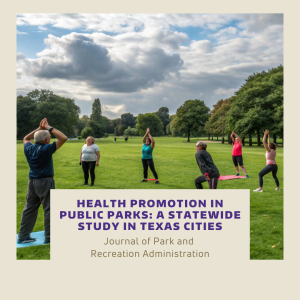Health Promotion in Public Parks: A Statewide Study in Texas Cities
Citation
Yeh, S. Y., Sansom, L., Maddock, J., & Frumkin, H. (2025). Health Promotion in Public Parks: A Statewide Study in Texas Cities. Journal of Park and Recreation Administration. doi.org/10.18666/JPRA-2025-12999
 City parks can play an important role in improving people’s health and reducing health disparities. This study looked at how city parks across Texas promote health. Researchers sent a survey to the 50 largest city park systems in the state. Thirty of them (60%) responded.
City parks can play an important role in improving people’s health and reducing health disparities. This study looked at how city parks across Texas promote health. Researchers sent a survey to the 50 largest city park systems in the state. Thirty of them (60%) responded.
All of the parks offered fitness classes. Most of them also offered health education, health fairs, and walking or running groups. Many parks also had programs for specific populations, including older adults, people who use wheelchairs, low-income visitors, and racial or ethnic minority communities.
Park systems often partnered with nonprofit health organizations, but fewer worked with hospitals, health departments, or medical professionals. Only a few offered programs led by doctors, such as Walk with a Doc.
The study shows that Texas city parks already do a lot to promote health, but there are still ways to improve. Opportunities include creating more partnerships with healthcare professionals, focusing more on mental health and nutrition, and measuring how well programs work.
Overall, the findings suggest that parks should make health promotion a key part of their planning and daily work. Strengthening partnerships and evaluating outcomes can help parks better support community health and equity.
Abstract
City parks can promote health and health equity through many pathways and programs. In this study, we aimed to characterize health promotion efforts in city parks across the state of Texas. We surveyed the state’s 50 largest municipal park systems, asking about: park system metrics (acreage, budget, etc.), facilities, health promotion programs, health promotion partnerships, park equity initiatives, and challenges and barriers to health promotion efforts. Among the 30 cities (60%) that responded, health promotion programs and initiatives were common. These included fitness classes (in 100% of responding park systems), health education programming (66.7%), health fairs, health screenings, and walking/running groups (56.7% each). Programs serving special populations included those for the elderly (97%), for visitors using wheelchairs (86.7%), for low-income visitors (73.3%), and for racial and ethnic minorities (56.7%). Park systems reported a wide range of partnerships with health organizations—nonprofit organizations more commonly than hospitals or health departments. Few park systems engaged health professionals directly, in efforts such as Walk with a Doc. This study confirms that parks promote health through diverse initiatives and partnerships. It also highlights further opportunities for health promotion in parks, including partnerships with health organizations, engagement of health professionals, enhanced emphasis on mental health and nutrition, and outcome evaluation. These findings emphasize the importance of making health promotion a central part of park planning and operations, especially by building partnerships with health professionals and evaluating program outcomes. Park leaders and advocates can use these insights to secure resources and align park programs with broader community health and equity goals.